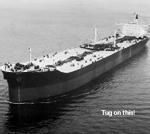Last week, oil spill fighters who’ve clamored for years to have rescue tugs deployed in the Strait of Juan de Fuca finally saw their ship—or tug—come in. Sort of. It took the late intervention of Representative Norm Dicks and Vice President Al Gore, but a rescue tug to guard against oil spills was finally stationed for the winter at Neah Bay, courtesy of the US Navy. At the same time, the US Interior Department approved an additional boost to tug protection that it had previously blocked: using surplus habitat restoration money from the 1991 Tenyo Maru fuel spill to fund additional tug time at Neah Bay. Marine advocates are on a roll, right?
Yes, but . . . in the Byzantine world of marine regulation, in which debates are highly technical and passionately polarized, victories are never quite what they seem. The tug huggers hoped to get $1 million or more from the Tenyo Maru settlement. But Fish & Wildlife representative Cindy Chafee says $400,000—about 5 weeks of tug service—is all that’s now available after other costs ate up the rest.
And the Barbara Foss, the tug sent out to Neah Bay last week, is less than a spill fighter’s dream. Joe Stohr, the state’s spill prevention manager, notes that it lacks the horsepower, fire-fighting capability, and vacuuming equipment for sucking up spilled fuel of the powerful Navy tugs that spill advocates have sought. Fred Felleman, the marine-protection advocate who pushed through both the interim tug at Neah Bay and the Tenyo Maru fund allocation, is still plumping for local government and industry to lease a surplus Navy tug, the Narranganset, for the strait. A draft agreement between the state, feds, and Makahs on spending the Tenyo Maru money calls for deploying a Navy tug or another equally powerful rig.
Felleman points to an event out on the stormy Washington coast last week as evidence of shortcomings in the current system. A freighter, the Sealand Kodiak, radioed that it had lost steering ability about 24 miles away from the coast. As per usual rules, its owners contracted to have a tug to assist if needed. (It wasn’t; the steering was fixed.) But that tug was dispatched from the regular fleet in Puget Sound, rather than from Neah Bay. Felleman contends that’s because (a) the Barbara Foss isn’t up to the job, and (b) the Coast Guard, which has long resisted deploying a tug on the strait, now resists using it so as not to give credit to the scheme.
But Coast Guard Chief Warrant Officer Chris Haley counters that the episode points to just the opposite conclusion: There was plenty of time to send a tug from the commercial pool to the Sealand Kodiak and no need for the rescue tug that Felleman has fought so hard to get. “The system worked regardless of whether there was a tug at Neah Bay,” says Haley. “So is that tug necessary?”








